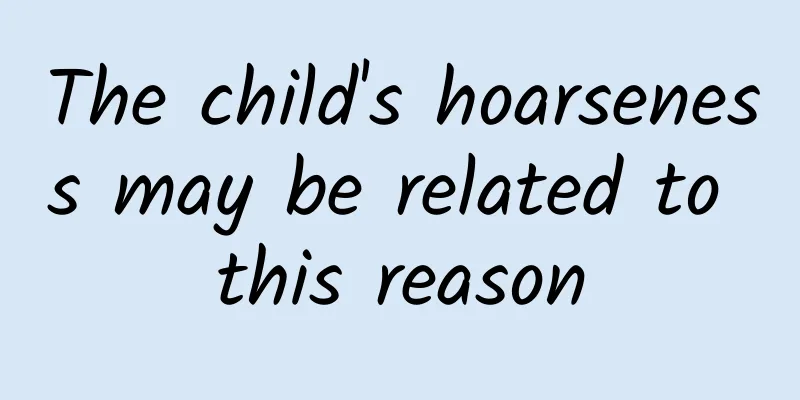The child's hoarseness may be related to this reason

|
We all know that our human body How does it make that sound? Let's go through a story Let’s understand how the vocal cords produce sound. First, let me introduce the two protagonists of the story. "Left-left" and "right-right". Zuo Zuo and You You are the girls living in Ling Ling The two vocal cords in the larynx.
But Zuo Zuo and You You couldn't be happy during this period. It turned out that Lingling went to elementary school and often suffered from upper respiratory tract infections. She also joined the school basketball cheerleading team and liked to yell at the top of her lungs with excitement. This made Zuo Zuo You You suffer a lot. On the one hand, they had to resist the attack of viruses and bacteria, and on the other hand, they were overloaded with work. After a month, Zuo Zuo and You You finally collapsed from exhaustion and went on strike. Ling Ling became hoarse and could not speak. The mother immediately took Lingling to the Otolaryngology and Head and Neck Surgery Department of the Children's Hospital for examination. The laryngoscopy results showed that Zuo Zuo and You You were sick and they had vocal cord nodules. Vocal cord nodules are the cause of hoarseness in children Very important reason. Before understanding vocal cord nodules, Let’s first understand hoarseness in children. According to different countries and regions Epidemiological surveys, The incidence of hoarseness in children It is 4%-23%. The incidence rate among boys is higher than that among girls. 3/4 of all patients The peak age of onset is 5-10 years old. What are the common factors that affect children’s voice? Disease factors Acute congestion and edema of the vocal cords caused by inflammatory infection (laryngitis, laryngotracheitis); Neoplasms on the vocal cords (laryngeal papilloma, vocal cord cyst); Vocal cord diseases (vocal cord nodules, vocal cord polyps) caused by excessive use of the voice and incorrect vocalization methods. Other factors Diet, climate, air pollution, ambient noise, stress, etc. Earlier we mentioned that Lingling Hoarseness is caused by vocal cord nodules. Now let us introduce in detail what vocal cord nodules are. Vocal cord nodules are a special type of chronic laryngitis. Chronic hoarseness in children 50% to 80% of the causes are vocal cord nodules. The main cause: "Voice abuse", such as shouting, excessive use of voice, etc. If the child has voice problems and the course of the disease exceeds two weeks, it is recommended to go to the ENT clinic for treatment. The vocal cords can be checked through electronic fiber laryngoscopes, etc., which show tiny fibrous nodular lesions on the inner edge of the vocal cords. Functional voice disorders Different from vocal cord nodules, There are usually no organic lesions in the larynx. Its causes may be psychological and mental stress, or it may be voice abuse, imbalance in laryngeal muscle strength, etc. School-age children may experience hoarseness, aphonia, etc., while adolescent children may experience interrupted pronunciation, labored speech, and abnormal tone. How are voice problems in children treated? Protect your throat. Perform voice training, Change the wrong habit of using voice. Improve pronunciation skills. first According to each person's voice problem, the voice therapist will develop a corresponding training plan; Secondly Relaxation training Relax your neck and shoulders first by massaging them and adjusting your breathing. again Abdominal breathing Use abdominal voice to change the wrong voice position and relax the throat muscles at last Let the children master the correct way to vocalize. At the same time, through voice education and psychological counseling, build up treatment confidence and eliminate concerns. How to protect your child’s throat? Avoid talking for long periods of time in a noisy environment; Actively treat colds and coughs, and pay attention to controlling the intensity of voice use; Guide children to use their voices correctly, and limit crying, shouting, reading aloud, etc. |
>>: The "cliff-like" temperature drop is "adding insult to injury" for some people...
Recommend
Does your body temperature rise during menstruation?
During a woman's menstrual period and ovulati...
What are the consequences of severe anemia?
Due to daily dietary problems or some factors of ...
Gastroesophageal reflux, a holiday disease that cannot be ignored
To prevent or alleviate gastroesophageal reflux d...
What is the ending of Three Lives Three Worlds: The Pillow Book? Which three lives are in Three Lives Three Worlds: The Pillow Book?
"Three Lives, Three Worlds: The Pillow Book&...
What are the characteristics of the 24 solar terms Spring Equinox? On which day of the Gregorian calendar does the Spring Equinox fall?
Spring breeze is one of the 24 solar terms, the f...
My nipples are sore. Am I pregnant?
The nipple is the most important part of a woman&...
Why does vaginal bleeding keep happening?
In daily life, many female friends may have encou...
Can you eat donkey-hide gelatin during menstruation?
Donkey-hide gelatin cake has the effect of nouris...
What are the precautions for cervical surgery?
Many patients with cervical erosion need surgical...
What happens if transparent leucorrhea contains blood?
Women's leucorrhea is generally transparent, ...
What to do if breasts become loose after breastfeeding
Many mothers will encounter such a situation: aft...
What to do if vagina has odor?
The pressure of life nowadays is getting greater ...
Can ectopic pregnancy be detected by ultrasound?
A normal pregnancy occurs in a woman's uterus...
What are the symptoms in the week before delivery?
The period before delivery is the most important ...
166 height standard weight female
A woman who is 166cm tall is considered a relativ...









